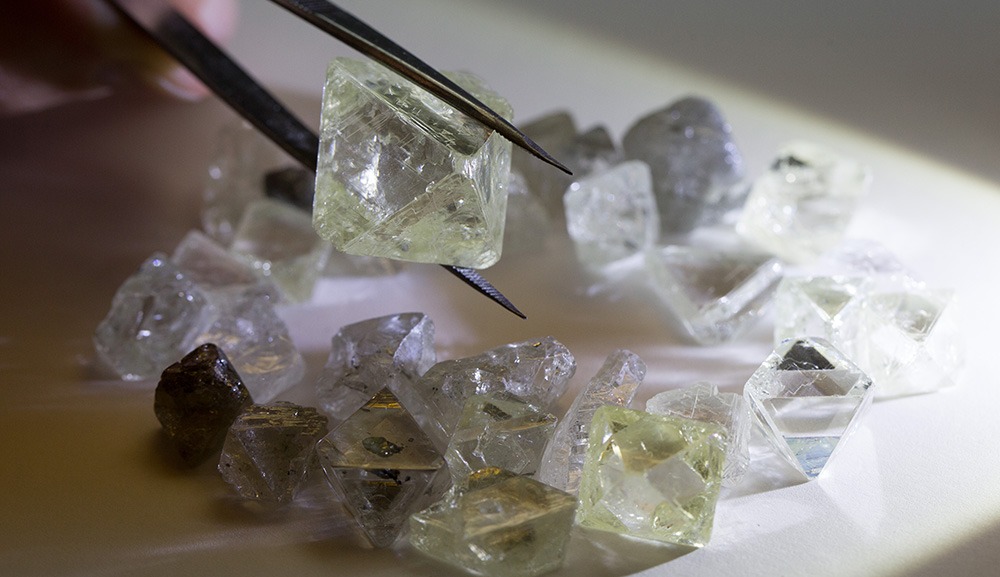ROCK SOLID inQ1 2018. The first 180 days of 2018 resulted in a varying degree of performances across diamond, gold and jewellery sectors overall. As diamond production faces the harsh reality of depleting resources, the increase in diamond production in Q1 from some major diamond companies was encouraging. There is talk within the industry, of a depleting supply between now and 2020 when the new discoveries would take shape and deliver. Gold demand took a beating of 7 percent. Under these circumstances and the current global environment the industry held a steady frame of mind.
DIAMONDS
Production at the major diamond producing companies delivered a mixed bag, some depicting sharp declines. Amidst these, the yearly production targets more or less have remained unchanged for most companies.
ALROSA
The Russian giant witnessed production slip from 8,930 thousand carats in Q12017 to 7,420 thousand carats in Q12018, a drop of 17 percent y-o-y. Ore and gravels processing in Q1 2018 was 5,712 thousand tons, down by 7 percent y-o-y and 21 percent q-o-q, in line with the company’s production plan.
Much of the rough diamond production dip is attributed to the reduced production at the Mirny Division owing to the shutdown of the Mir underground mine following the accident in August 2017. Other factors causing production to slip – processing of lower grade ore from the Jubilee pipe; termination of processing of ore from the Udachny open-pit after completion of open-pit mining.
The up-side of the three months at Alrosa was the continued growth in production at its key expansion projects wherein the output delivered an increase year-on-year at Udachny underground mine (growth by 25 percent on y-o-y basis) and at Severalmaz (up by 49 percent).
FY2018 Production Target: 36.6 million carats (2017: 39.5 million carats).
Preliminary SaleResult in Q1 2018:
In Value Terms:
Rough diamond sales – USD 1.582 billion.
Polished diamond sales – USD 23.7 million.
In Volume Terms: 13.3 million carats of diamonds (10.1 million carats of gem-quality diamonds at an average price of USD 154 per carat, and 3.2 million carats of industrial diamonds at an average price of USD 8.0 per carat.)
DE BEERS
With a 15 percent increase on y-o-y, production amounted to 8.5 million carats in Q1.It reflected the ramp-up of production from GahchoKué in Canada, which reached nameplate capacity in Q2 2017, and increased production from Orapa in Botswana in response to the sustained healthy trading conditions. Majority of its mines delivered an increased production level compared to Q1 2017.
Botswana (DEBSWANA): Production increased 12 per cent to 5.8 million carats.Orapa production increased 26 per cent to 2.8 million carats.
Namibia (Namdeb Holdings): Production increased 12 per cent to 528,000 carats.
South Africa (De Beers Consolidated Mines): Production was in line with Q1 2017 at 1.1 million carats.
Canada: Production increased 69 per cent to 1.1 million carats due to the ramp-up of GahchoKué.
FY2018 Production Guidance: 34 to 36 million carats, subject to trading conditions. (2017: 33.1 million carats)
Sale:
In Volume Terms:8.8 million carats (8.4 million carats on a consolidated basis) from two Sights, compared with 14.1 million carats (13.7 million carats on a consolidated basis) from three Sights in Q1 2017.
In 2017, there was number of Sights and also, Sight 1 had witnessed unusually strong demand for lower value goods following the effects of Indian demonetization in Q4 2016, causing higher than normal sales volume.
RIO TINTO
Diamond production overall increased by 11 percent on y-o-y basis in Q1 2018 to 4,616 thousand carats. At Argyle, the said production was up 18 percent on y-o-y basis (3,551 thousand carats in Q1 2018), due to relatively fewer weather disruptions and the additional processing of higher grade alluvial tailings. At Diavik, carats recovered were 6 percent lower (1,065 thousand carats in Q1 2018) than the corresponding period in 2017 due to lower recovered grades. Development of the A21 project is ahead of schedule and the mine is expected to be at full production capacity during the fourth quarter of 2018.
FY 2018 Production Guidance: Between 17 and 20 million carats.
Looking at a comparison over last year’s figures from the three major mining companies, the estimated overall diamond supply this year seems to be slightly less than last year, yet the companies have expressed a satisfied closure to the quarter’s performance. Also, sales have been healthy with retailers restocking with a helpful Chinese New Year and good demand in the holiday season. Moving ahead, there are many factors to keep an eye on – consumer demand and industry efforts made towards diamond promotion, polished and rough diamond pricing, the manufacturer’s stock appetite, finance and overall transparent business operations; the impact of the Nirav Modi bank fraud case in India and its implications on the consumer demand and trade. Yet, companies predict a steady year for polished and rough diamonds, with stable demand and polished prices looking good.
GOLD
SUPPLY & PRODUCTION
According to World Gold Council’s Gold Demand Trends Report for Q1 2018, total gold supply was up 3 percent to 1,063.5t owing to a modest increase in producer hedging of 5.8t. Mine production increased marginally by 1 percent on y-o-y basis to 770t in Q1’2018 and growth in the future is expected to be driven by brownfield projects. The rise in production reflected the typical seasonality and some subplots – signs of rising cost pressures, a renewed focus on growth by gold miners, especially through brownfield projects. The various production centers delivered a mixed bag. Mining in China was affected with the stricter environmental norms implemented in 2017 and slipped 8 percent on y-o-y basis. But Indonesia delivered a 12 percent increase on y-o-y basis owing to the higher grades continually being mined at Grasberg. Their positive upward trend in output is brewing owing to Natalka being ramped up to full production before year-end. Production was up in Canada (12 percent y-o-y and Russia (3-4 percent). Recycled gold stood almost flat.
Production outlook for 2018: Modest growth is expected with some greenfield projects, and mainly spearheaded by an expansion of existing mines and ramp-up of recent projects.
DEMAND:
The said quarter demand of 973.5t (a fall of 7 percent on y-o-y basis) was the lowest first quarter demand since 2008. The dip in investment demand of gold bars and gold-backed ETFs partially due to range-bound gold prices resulted in global demand falling.
JEWELLERY:
According to the World Gold Council’s Gold Demand Trends Q1 2018, there was steadiness in global demand for gold jewellery at 487.7t. falling marginally by 1 percent from 491.6t of Q1 2017. Stable gold prices and a broad supportive economic environment helped demand. Growth in China and US compensated for the weak Indian demand.
INVESTMENT
Global investment demand slipped 27 percent to 287.3t. Gold and bar investment demand was down 15 percent to 254.9t and demand for gold-backed ETFs was down 66 percent to 32.4t. India’s investment demand dropped 13 percent whereas in China investment was down by 26 percent.
GOLD JEWELLERY IN INDIA:
In the world’s major gold consumption market, gold jewellery demand in Q1 2018 dipped 12 percent from 99.2t in Q1 2017 to 87.7t – the third weakest quarter for 10 years and a deep dive from Q4 2017 which WGC described as the strongest Q4 on record (at 189.6t). A depreciating rupee magnified the increase in international US$ gold price. Consumers perceived volatility and deferred buying, while the fewer number of wedding days in the quarter was the major factor to affect demand. Gold imports dipped around 50 percent in anticipation of the Union budget, stock inventories of 2017 began to clear. Larger and regional retail chains accounted for better sales compared to medium and single-chain stores. While the industry overall is progressing to make GST a part of its routine operations, the organized corporate jewelers see GST as a beneficial growth step.
GOLD JEWELLERY IN CHINA:
There was a 7 percent increase in gold jewellery demand in Q1 2018 touching 187.8t. This translates into a three-year high for China. Jewellery centered around the Year of the Dog pushed demand during Lunar New Year holiday. Good demand was cited for 18-carat K Gold and 3D hard gold jewellery, designs reflecting fashion, innovation and modernity and 22-carat gold jewellery. 24-carat jewellery saw low key demand.
The US witnessed gold jewellery demand rising 2 percent to 23.3t – the highest since 2009.
GLOBAL GOLD JEWELLERY DEMAND OUTLOOK: Sector is weak in comparison to the longer-term historic average levels: five- and ten-year quarterly average demand was 592.1t and 556.3t, respectively.
THE INDIAN ENVIRONMENT
It may seem that the gem and jewellery industry in India had its platter full with compliance to the new GST (Goods and Service Tax) but developments on many fronts are in motion now. The biggest challenge today is in retaining confidence and transparency, at all levels. The recent banking fraud case of Nirav Modi has pressurized both the banking system and the industry, straining finance availability for the industry players. Confidence has weakened even at consumer level. Gross gem and jewellery exports slipped 5.06 percent om y-o-y basis to USD 40, 972.36 million. Imports in the year stood at USD 31, 516.70 million after a 9.69 percent rise. Exports of cut and polished diamonds was up 4.17 percent to USD 23,732.96 million, while rough diamond imports were worth USD 18,889.01 million rising 10.59 percent. Exports of gold jewellerywas at USD 9,673.23 million after a 10.91 percent increase on y-o-y basis.
A landmark victory was the success for the first Bharat Diamond Week in April adding to India’s exports and its global leadership.
With the Indian industry trade bodies doing their best to create a clear and progressive internal business environment, mining companies holding steady and prices looking encouraging, the year could well be spent with a relieving optimism if all stays steady.


